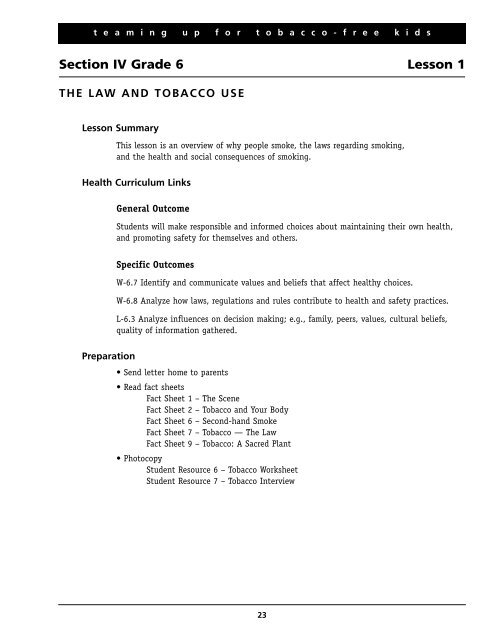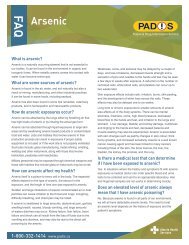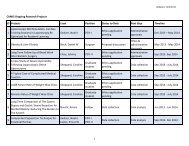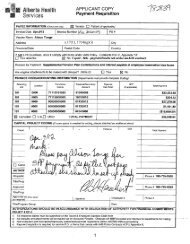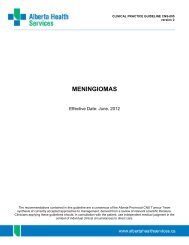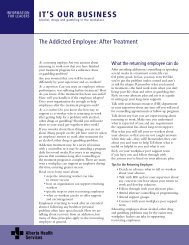Teaming Up for Tobacco-Free Kids: Teachers' Resource Kit ...
Teaming Up for Tobacco-Free Kids: Teachers' Resource Kit ...
Teaming Up for Tobacco-Free Kids: Teachers' Resource Kit ...
You also want an ePaper? Increase the reach of your titles
YUMPU automatically turns print PDFs into web optimized ePapers that Google loves.
t e a m i n g u p f o r t o b a c c o - f r e e k i d s<br />
Section IV Grade 6 Lesson 1<br />
THE LAW AND TOBACCO USE<br />
Lesson Summary<br />
This lesson is an overview of why people smoke, the laws regarding smoking,<br />
and the health and social consequences of smoking.<br />
Health Curriculum Links<br />
Preparation<br />
General Outcome<br />
Students will make responsible and in<strong>for</strong>med choices about maintaining their own health,<br />
and promoting safety <strong>for</strong> themselves and others.<br />
Specific Outcomes<br />
W-6.7 Identify and communicate values and beliefs that affect healthy choices.<br />
W-6.8 Analyze how laws, regulations and rules contribute to health and safety practices.<br />
L-6.3 Analyze influences on decision making; e.g., family, peers, values, cultural beliefs,<br />
quality of in<strong>for</strong>mation gathered.<br />
• Send letter home to parents<br />
• Read fact sheets<br />
Fact Sheet 1 – The Scene<br />
Fact Sheet 2 – <strong>Tobacco</strong> and Your Body<br />
Fact Sheet 6 – Second-hand Smoke<br />
Fact Sheet 7 – <strong>Tobacco</strong> — The Law<br />
Fact Sheet 9 – <strong>Tobacco</strong>: A Sacred Plant<br />
• Photocopy<br />
Student <strong>Resource</strong> 6 – <strong>Tobacco</strong> Worksheet<br />
Student <strong>Resource</strong> 7 – <strong>Tobacco</strong> Interview<br />
23
t e a m i n g u p f o r t o b a c c o - f r e e k i d s<br />
Section IV Grade 6 - Lesson 1<br />
Lesson Duration<br />
Activities<br />
Assessment<br />
Vocabulary<br />
60 minutes<br />
Ask students to estimate the percentage of youth, between the ages of 12 and 19, who<br />
smoke (see Fact Sheet 1). After revealing the actual number of youth smokers, discuss<br />
any discrepancy from their estimate.<br />
Ask students to <strong>for</strong>m small work groups. Discuss the questions listed on Student <strong>Resource</strong> 6<br />
(<strong>Tobacco</strong> Worksheet) and have each group record its answers.<br />
Have a class discussion about the results and fill in missing in<strong>for</strong>mation. See Fact Sheets 1,<br />
2, 6, 7 and 9 <strong>for</strong> the answers.<br />
Discuss how knowing the facts about tobacco will help individuals <strong>for</strong>m personal values<br />
and beliefs regarding tobacco use.<br />
Distribute Student <strong>Resource</strong> 7 (<strong>Tobacco</strong> Interview) to students. Ask students to interview<br />
parents/guardians about their values and beliefs regarding tobacco.<br />
Instruct students to write a one-page report about their own values and beliefs regarding<br />
tobacco use. Suggest that students include reasons why they would or would not choose<br />
to use tobacco products.<br />
• Evaluate students’ participation in the classroom discussion.<br />
• Evaluate interview worksheets.<br />
• Evaluate one-page written reports.<br />
• Furnish<br />
• Possess<br />
• Consume<br />
Adapted from: bc.tobaccofacts: A <strong>Tobacco</strong> Prevention <strong>Resource</strong> <strong>for</strong> Teachers - Grade 6. British Columbia Ministry<br />
of Health and Ministry of Education, 1999.<br />
24
t e a m i n g u p f o r t o b a c c o - f r e e k i d s<br />
Section IV Grade 6 Lesson 2<br />
PEER PRESSURE<br />
Lesson Summary<br />
Students will experience peer pressure within a controlled environment. Afterwards,<br />
they’ll discuss their experiences and feelings. Students will learn techniques <strong>for</strong> responding<br />
to peer pressure and share thoughts about other possible pressures they may face when<br />
starting junior high next year.<br />
Health Curriculum Links<br />
General Outcomes<br />
Students will make responsible and in<strong>for</strong>med choices to maintain health and to promote<br />
safety <strong>for</strong> themselves and others.<br />
Students will use resources effectively to manage and explore life roles and career<br />
opportunities.<br />
Specific Outcomes<br />
L-6.3 Analyze influences on decision making; e.g., family, peers, values, cultural beliefs,<br />
quality of in<strong>for</strong>mation gathered.<br />
L-6.6 Analyze and apply effective age-appropriate strategies to manage change;<br />
e.g., predict, plan and prepare <strong>for</strong> transition to next school level.<br />
R-6.8 Analyze the influence of groups, cliques and alliances on self and others;<br />
e.g., at home, in school, in the community.<br />
Lesson Duration<br />
Preparation<br />
Materials<br />
60 minutes<br />
• Send letter home to parents<br />
• Identify one or more students who are considered leaders by classmates.<br />
• Photocopy<br />
Student <strong>Resource</strong> 2 – Refusal Skills<br />
• Candy bowl<br />
25
t e a m i n g u p f o r t o b a c c o - f r e e k i d s<br />
Section IV Grade 6 – Lesson 2<br />
Activities<br />
Place a bowl of candies (e.g., Skittles® or Smarties®) on a desk at the front of<br />
the classroom. Assign students a small task to keep them occupied (task does not have<br />
to be health-related). Be<strong>for</strong>e leaving the room, ask students not to eat any candies<br />
explaining they are <strong>for</strong> a lesson later in the day.<br />
Prior to commencing this lesson in peer pressure, confidentially speak to your identified<br />
classroom leader(s). Ask that they defy your instructions and sneak candies from the bowl.<br />
Suggest that as they sneak the candies they use statements such as, “He/She will never<br />
notice!” or “Do you think she/he counted them?”<br />
To complete this lesson, try to catch students in the act or continue with other work until<br />
students confess.<br />
IMPORTANT! Explain to the class that you asked the student(s) to initiate the sneaking.<br />
Tell them that this exercise was planned to demonstrate peer pressure.<br />
It is important that your class understands that their classmate(s) was defying you to assist<br />
in a demonstration only. Your assisting student must be cleared by peers of any wrongdoing.<br />
Discussion<br />
Explain that the exercise was a peer pressure demonstration. Probe <strong>for</strong> reactions and ask<br />
the kids to explain why they chose to participate (or not participate) in “sneaking” candies.<br />
Discuss examples of other peer pressure situations. Ask students to imagine the candies had<br />
been cigarettes or spit tobacco. Would they have felt pressured to try it?<br />
Discuss how peer pressure influences individual values and beliefs. Ask how students think<br />
they would react if an older junior high student pressured them. Have students consider<br />
possible pressures they may experience in junior high. Ask students to discuss techniques<br />
they can use to avoid feeling pressured by older kids.<br />
Distribute Student <strong>Resource</strong> 2 (Refusal Skills) and discuss refusal techniques. Ask students<br />
to brainstorm other ideas and personalize strategies <strong>for</strong> dealing with peer pressure<br />
(especially from older students or siblings). Divide students into groups of three or four<br />
and instruct them to create short skits using the refusal strategies they have developed.<br />
Assessment<br />
• Evaluate students’ participation in the discussion.<br />
• Evaluate content of students’ skits.<br />
Variations<br />
Any type of candy or cookie may be used.<br />
The assisting student may be from another classroom or higher grade (if co-located<br />
with a junior high school).<br />
Have students complete a written assignment about their personal strategies <strong>for</strong> coping<br />
with the transition to junior high.<br />
Have students prepare skits to be per<strong>for</strong>med <strong>for</strong> younger students in lower grades.<br />
Adapted from: Howland, Rebecca, Florida State University Science – <strong>Tobacco</strong> and You, Teachers’ <strong>Resource</strong> Website.<br />
Online at www.scienceu.fsu.edu/communications/lessonplans.<br />
26
t e a m i n g u p f o r t o b a c c o - f r e e k i d s<br />
Section IV Grade 6 Lesson 3<br />
THE MEDIA TRAP<br />
Lesson Summary<br />
Students will assess the media’s influence on their life decisions by assessing advertisements<br />
and/or television programming.<br />
Health Curriculum Links<br />
General Outcome<br />
Students will make responsible and in<strong>for</strong>med choices about maintaining their health<br />
and promoting safety <strong>for</strong> themselves and others.<br />
Specific Outcomes<br />
W-6.7 Identify and communicate values and beliefs that affect healthy choices.<br />
R-6.1 Recognize that individuals can choose their own emotional reactions to events<br />
and thoughts.<br />
R-6.3 Develop personal strategies <strong>for</strong> dealing with stress/change; e.g., using humour, relaxation,<br />
physical activity.<br />
Lesson Duration<br />
Preparation<br />
60 minutes<br />
• Send letter home to parents<br />
• Read fact sheet<br />
Fact Sheet 8 – Marketing<br />
• Photocopy<br />
Student <strong>Resource</strong> 8 – Media Presentations<br />
• Ask students to collect tobacco ads from magazines or to tape TV programs showing<br />
tobacco being used (examples can be found on www.badvertising.org). If you have time<br />
constraints you may want to assign the collection of ads as homework the class be<strong>for</strong>e.<br />
• If using printed examples, create an overhead transparency of one<br />
of the ads collected. If using taped examples, reserve a VCR.<br />
27
t e a m i n g u p f o r t o b a c c o - f r e e k i d s<br />
Section IV Grade 6 – Lesson 3<br />
Activities<br />
Assessment<br />
Variation<br />
Vocabulary<br />
Using an overhead projector, show students one tobacco ad from a magazine.<br />
Initiate a discussion about the tobacco industry’s message. Using the appropriate section<br />
of Student <strong>Resource</strong> 8 (Media Presentations), have the class analyze the ad.<br />
Ask students to <strong>for</strong>m small work groups. Give groups a print ad or taped program segment.<br />
Using Student <strong>Resource</strong> 8 (Media Presentations), have each group analyze the advertisement<br />
or TV segment and report back to the class. Ask the groups to hand in the written analysis.<br />
Then, discuss how the media can influence values and beliefs and how tobacco companies<br />
use advertising to influence youth.<br />
• Evaluate students’ participation in class discussions.<br />
• Evaluate students’ Media Presentations worksheets.<br />
Instruct individual students (or student pairs) to analyze a print advertisement using<br />
Student <strong>Resource</strong> 8 (Media Presentations). To encourage parental assistance with<br />
this homework assignment, adapt the sample letter to parents (see table of contents)<br />
and send home to parents.<br />
Discuss tobacco sponsorships and how they compare to advertising.<br />
Manipulation<br />
Adapted from: Media Sharp: Analyzing <strong>Tobacco</strong> and Alcohol Messages. The Office on Smoking and Health -<br />
Centres <strong>for</strong> Disease Control, Centre <strong>for</strong> Substance Abuse Prevention Substance Abuse and Mental Health Services<br />
Administration, The American Academy of Pediatrics and National Education Association Health In<strong>for</strong>mation<br />
Network; Our Health - Our Future - Our Choice Integrated <strong>Tobacco</strong> <strong>Resource</strong>: Book 1. Board of School Trustees<br />
School District 2, 1996; Back Talk, Media Wise and Feeling Good. Health Canada.<br />
28


